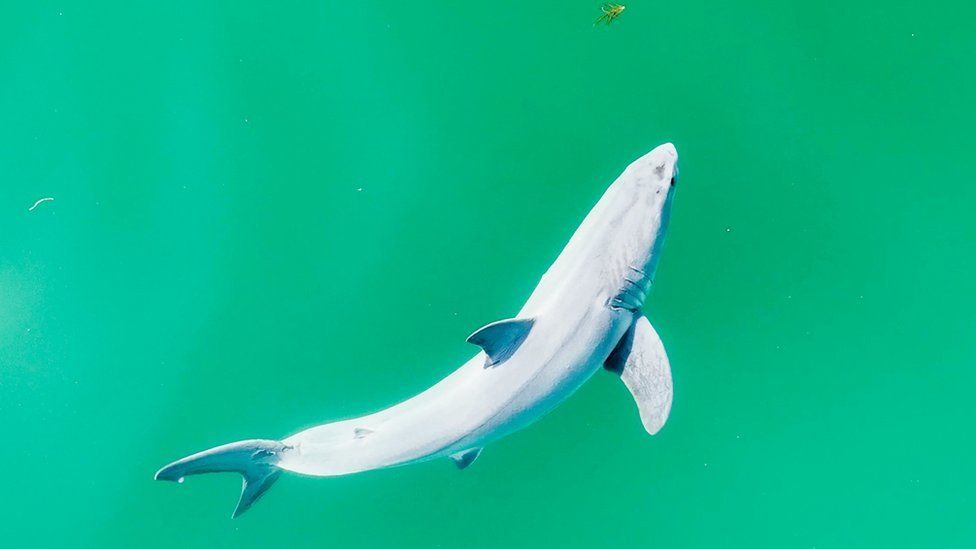ARTICLE AD BOX
 Image source, TheMalibuArtist
Image source, TheMalibuArtist
By James Clayton
BBC North America technology reporter
The gap in our knowledge of great white sharks may have just been narrowed thanks to a YouTuber.
As far as experts are aware, the birth of a great white shark has never been witnessed, but Carlos Gauna may have captured the closest thing to that.
Carlos has found fame on YouTube as TheMalibuArtist and has filmed incredible shots of sharks from above with his drone.
"You're basically viewing the sharks through a magnifying glass that they don't know is watching them," he says.
His YouTube videos, which have racked up tens of millions of views, often show great whites swimming concerningly close to humans.
"It does raise my heart rate sometimes. I've yet to see a shark get aggressive with or show aggressive behaviour around a human, but [it's] just human instinct," he says.
Image source, TheMalibuArtist
Image caption,Carlos often sees people and sharks closer together than you might think
On a beach near Santa Barbara, California, last year, a sighting of a different nature got Carlos's pulse going.
He had already seen large sharks in the area when he stumbled across something he had never seen before.
"This little bitty white, almost albino-looking, white shark came up to the surface," he says.
As Carlos brought down his drone closer, more details of the shark emerged. It was white all over, but the white layer seemed to be flaking off.
At the time, Carlos was with shark researcher Phil Sternes, from the University of California, Riverside, who could not believe what he was seeing.
Image source, TheMalibuArtist
Image caption,White flakes were left behind in the water behind the shark
"I'm like, 'oh my goodness, this could be a newborn'," he says.
"We're both falling out of our seats with excitement at that point. It was quite a moment."
What got Phil particularly excited was the shape of the shark, whose fins were more rounded than usual. That is something you see in shark embryos and newborns.
He says the white layer could have been evidence the shark had just been born and still had a mucus-like substance on its body.
James Worthington, from the University of San Diego, helped the pair size the shark. Using the drone's distance from the sea surface and the crop factor, he worked out it was roughly 1.5m (4.9ft) long - about the right size for a newborn.
Their observation has been published in the journal Environmental Biology of Fishes.
Image source, TheMalibuArtist
Image caption,Carlos captures drone footage of sharks for his YouTube channel
However, some marine biologists urge caution at jumping to the conclusion that it is definitely a newborn great white shark.
Dr Chris Lowe, from California State University's shark lab believes the finding is interesting, but there are other explanations for the white layer.
"Sure, this could be a newborn shark, or it could be a shark with a skin disease, or it could be a number of other things we haven't even thought of," he says.
"Unfortunately, it's a sample size of one. I think many scientists would agree that in order for us to consider this area of pupping location, we would need a lot more evidence."
In their report, Phil and Carlos acknowledge that the shark could have a skin condition, but Phil says: "What's unique about this shark is it has a white layer.
"I looked in the literature extensively, we couldn't find anything that matches up to this. So it could be an unknown skin condition that's never been documented before, which is also unique."
However, they believe that theory ignores other evidence from Carlos's video - the aggressiveness of the flaking, the shape of the fins and the size of the shark.
Drones have ushered in a revolution in shark filming, and not just for citizen scientists like Carlos. They are used by shark scientists to analyse the fish's behaviour, with some amazing observations.
"We just completed a two-year study where one of my grad students went out and flew drone surveys at 26 California beaches every month for two years," Dr Lowe says.
"What they found was that aggregation sites where we have juvenile white sharks day in day out, there were interactions with people every single day - multiple interactions."
That is exactly what Carlos finds. Great whites are much more common along California's beaches than you might think, and it is not uncommon for them to get close to humans.
Armed with a drone and patience, he is hoping to one day become the first person to film one being born.

 1 year ago
119
1 year ago
119








 English (US) ·
English (US) ·